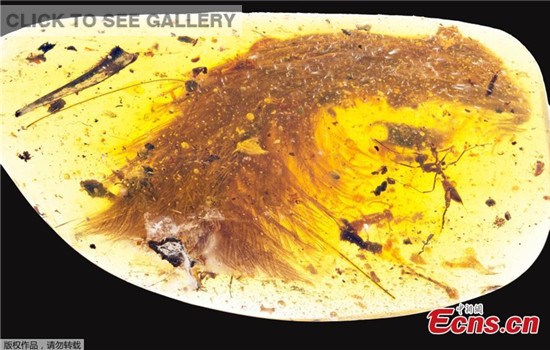A perfectly preserved tail of a feathered dinosaur dating back to millions of years ago has been found in amber for the first time and is expected to make great contributions to the study of the feather's evolution.
Xing Lida from the China University of Geosciences in Beijing and Ryan McKellar of the Royal Saskatchewan Museum in Canada led a research team that studied the fossil and published the finding in the journal Current Biology on Dec 8.
Xing Lida, the first author, said that he found the remarkable fossil at an amber market in Myitkina, Myanmar, in summer 2015. He tracked down the amber miner to see the place where the fossil was found.
"It is the first time that we have found a piece of amber with dinosaur material," said Xing.
He believes the amber was formed in nature because of the resin's flow pattern and the extinct ant wrapped in it. The fluorescent reactions could also have played a role in the formation.
The fossil was tested and the result show that it dates back to mid-Cretaceous, about 99 million years ago.
The preserved tail in amber is about 3.85 centimeters long, full of feather, and researchers assume that the dinosaur would be about 18.5 centimeters tall.
"We can be sure of the source because the vertebrae are not fused into a rod or pygostyle as in modern birds and their closest relatives," he said.
"Instead, the tail is long and flexible, with keels of feathers running down each side."
The tail's feathers lack the well-developed central shaft – a rachis – that modern birds have. Instead it has fine branching tiers, which demonstrate that the barbs and barbules of modern feathers formed before the rachis developed.
"We could possibly find other body parts of the dinosaur in other ambers, or the fossils of other ancient creatures in ambers," said Xing.



















































